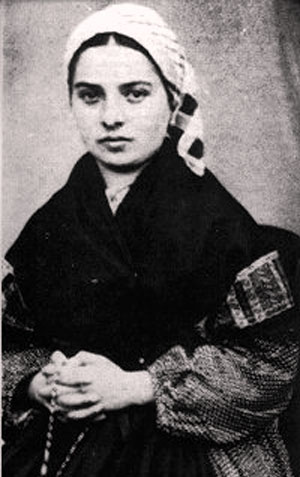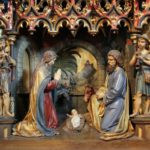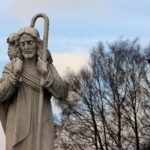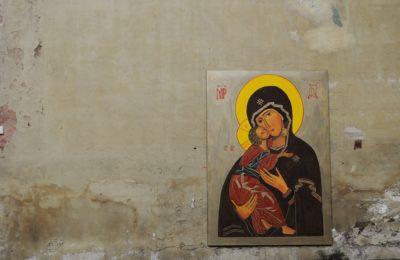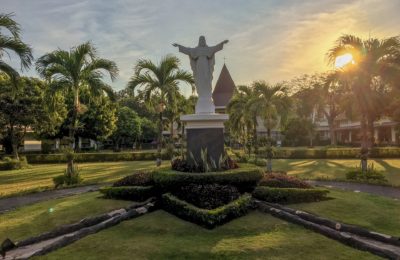On this day in 1879, the saint-visionary of Lourdes, St. Bernadette Soubirous, died after a life of just thirty-five years. Though she had been the recipient of church confirmed visions of the Blessed Virgin Mary, she lived a simple post-apparition life of service in the order of the Sisters of Charity in Nevers, France. Her days in the religious order were characterized by what she had learned from the Blessed Virgin Mary: prayer and penance. She said, “The Virgin used me as a broom to remove the dust. When the work is done, the broom is put behind the door again.” The following is an excerpt from one of her letters which describes in her own words the initial apparition of Our Lady, and subsequent events:
“I had gone down one day with two other girls to the bank of the river Gave when suddenly I heard a kind of rustling sound. I turned my head toward the field by the side of the river, but the trees seemed quite still and the noise was evidently not from them. Then I looked up and caught sight of the cave where I saw a lady wearing a lovely white dress with a bright belt. On top of each of her feet was a pale yellow rose, the same color as her rosary beads. At this I rubbed my eyes, thinking I was seeing things, and I put my hands into the fold of my dress where my rosary was. I wanted to make the sign of the cross, but for the life of me I couldn’t manage it, and my hand just fell down. Then the lady made the sign of the cross herself, and at the second attempt I managed to do the same, though my hands were trembling. Then I began to say the rosary while the lady let her beads clip through her fingers, without moving her lips. When I stopped saying the Hail Mary, she immediately vanished. I asked my two companions if they had noticed anything, but they said no. Of course, they wanted to know what I was doing, and I told them that I had seen a lady wearing a nice white dress, though I didn’t know who she was. I told them not to say anything about it, and they said I was silly to have anything to do with it. I said they were wrong, and I came back next Sunday, feeling myself drawn to the place…. The third time I went, the lady spoke to me and asked me to come every day for fifteen days. I said I would and then she said that she wanted me to tell the priests to build a chapel there. She also told me to drink from the stream. I went to the Gave, the only stream I could see. Then she made me realize she was not speaking of the Gave, and she indicated a little trickle of water close by. When I got to it I could only find a few drops, mostly mud. I cupped my hands to catch some liquid without success, and then I started to scrape the ground. I managed to find a few drops of water, but only at the fourth attempt was there sufficient for any kind of a drink. The lady then vanished and I went back home. I went back each day for fifteen days, and each time, except one Monday and one Friday, the lady appeared and told me to look for a stream and wash in it and to see that the priests build a chapel there. I must also pray, she said, for the conversion of sinners. I asked her many times what she meant by that, but she only smiled. Finally, with outstretched arms and eyes looking up to heaven, she told me she was the Immaculate Conception. During the fifteen days she told me three secrets, but I was not to speak about them to anyone, and so far I have not.”
“She told me she was the Immaculate Conception.”
This reminds me of the last article written in 1941 by St. Maximilian Kolbe just hours before his last arrest by the Nazis, Who Then Are You, O Immaculate Conception. This reflection on the Immaculate Conception was written by one of the most serious devotees, and scholars, of Our Lady of the last century, and is worth reflecting on, especially on this day which the Church dedicates to St. Bernadette. The last article written by St. Maximilian Kolbe:
Immaculate Conception. These words fell from the lips of the Immaculata herself. Hence, they must tell us in the most precise and essential manner who she really is.
Since human words are incapable of expressing divine realities, it follows that these words: “Immaculate” and “Conception” must be understood in a much more profound, much more beautiful and sublime meaning than usual: a meaning beyond that which human reason at its most penetrating, commonly gives to them.
St. Paul wrote, quoting the Prophet Isaiah: “‘Things that the eye has not seen, that the ear has not heard, that the heart of man has not imagined’ (Is. 64:4), such are the good things that God has prepared for those who love him” (1 Cor. 2:9). Here, these words apply fully.
However, we can and should reverently inquire into the mystery of the Immaculata and try to express it with words provided by our intelligence using its own proper powers.
Who then are you, O Immaculate Conception?
Not God, of course, because He has no beginning. Not an angel, created directly out of nothing. Not Adam, formed out of the dust of the earth (Gen. 2:7). Not Eve, molded from Adam’s rib (Gen. 2:21). Not the Incarnate Word, Who exists before all ages, and of Whom we should use the word “conceived” rather than “conception.” Humans do not exist before their conception, so we might call them created “conceptions.” But you, O Mary, are different from all other children of Eve. They are conceptions stained by original sin; whereas you are the unique, Immaculate Conception.
Everything which exists, outside of God Himself, since it is from God and depends on Him in every way, bears within itself some semblance to its Creator; there is nothing in any creature which does not betray this resemblance, because every created thing is an effect of the Primal Cause. It is true that the words we use to speak of created realities express the divine perfections only in a halting, limited and analogical manner. They are only a more or less distant echo–as are the created realities that they signify–of the properties of God Himself.
Would not “conception” be an exception to this rule? No; there is never any such exception.
The Father begets the Son; the Spirit proceeds from Father and Son. These few words sum up the mystery of the life of the Most Blessed Trinity and of all the perfections in creatures which are nothing else but echoes, a hymn of praise, a many-hued tableau, of this primary and most wondrous of all mysteries.
We must perforce use our customary vocabulary, since it is all we have; but we must never forget that our vocabulary is very inadequate.
Who is the Father? What is His personal life like? It consists in begetting, eternally; because He begets His Son from the beginning, and forever.
Who is the Son? He is the Begotten-One, because from the beginning and for all eternity He is begotten by the Father.
And who is the Holy Spirit? The flowering of the love of the Father and the Son. If the fruit of created love is a created conception, then the fruit of divine Love, that prototype of all created love, is necessarily a divine “Conception.” The Holy Spirit is, therefore, the “uncreated, eternal conception,” the prototype of all the conceptions that multiply life throughout the whole universe.
The Father begets; the Son is begotten; the Spirit is the “conception” that springs from their love; there we have the intimate life of the three Persons by which they can be distinguished one from another. But they are united in the oneness of their Nature, of their divine existence.
The Spirit is, then, this thrice holy “conception,” this infinitely holy, Immaculate Conception.
Everywhere in this world we notice action, and the reaction which is equal but contrary to it; departure and return; going away and coming back; separation and reunion. The separation always looks forward to union, which is creative. All this is simply an image of the Blessed Trinity in the activity of creatures. Union means love, creative love. Divine activity, outside the Trinity Itself, follows the same pattern. First, God creates the universe; that is something like separation. Creatures, by following the natural law implanted in them by God, reach their perfection, become like Him, and go back to Him. Intelligent creatures love Him in a conscious manner; through this love they unite themselves more and more closely with Him, and so find their way back to Him. The creature most completely filled with this love, filled with God Himself, was the Immaculata, who never departed in the least from God’s will. United to the Holy Spirit as His spouse, she is one with God in an incomparably more perfect way than can be predicated of any other creature.
What sort of union is this? It is above all an interior union, a union of her essence with the “essence” of the Holy Spirit. The Holy Spirit dwells in her, lives in her. This was true from the first instant of her existence. It was always true; it will always be true.
In what does this life of the Spirit in Mary consist? He Himself is uncreated Love in her; the Love of the Father and of the Son, the Love by which God loves Himself, the very love of the Most Holy Trinity. He is a fruitful Love, a “Conception.” Among creatures made in God’s image the union brought about by married love is the most intimate of all (cf. Mt. 19:6). In a much more precise, more interior, more essential manner, the Holy Spirit lives in the soul of the Immaculata, in the depths of her very being. He makes her fruitful, from the very first instant of her existence, all during her life, and for all eternity.
This eternal “Immaculate Conception” (which is the Holy Spirit) produces in an immaculate manner divine itself in the womb (or depths) of Mary’s soul, making her the Immaculate Conception, the human Immaculate Conception. And the virginal womb of Mary’s body is kept sacred for Him; there He conceives in time–because everything that is material occurs in time–the human life of the Man-God.
And so the return to God (which is love), that is to say the equal and contrary reaction, follows a different path from that found in creation. The path of creation goes from the Father through the Son and by the Holy Spirit; this return trail goes from the Spirit through the Son back to the Father; in other words, by the Spirit the Son becomes incarnate in the womb of the Immaculata; and through this Son love returns to the Father.
And she (the Immaculata), grafted into the Love of the Blessed Trinity, becomes from the first moment of her existence and forever thereafter the “complement of the Blessed Trinity.”
In the Holy Spirit’s union with Mary we observe more than the love of two beings; in one there is all the love of the Blessed Trinity; in the other, all of creation’s love. So it is that in this union heaven and earth are joined; all of heaven with all the earth, the totality of eternal love with the totality of created love. It is truly the summit of love.
At Lourdes, the Immaculata did not say of herself that she had been conceived immaculately, but, as St. Bernadette repeated it, “Que soy era immaculada councepciou”: “I am the Immaculate Conception.”
If among human beings the wife takes the name of her husband because she belongs to him, is one with him, becomes equal to him and is, with him, the source of new life, with how much greater reason should the name of the Holy Spirit, Who is the divine Immaculate Conception, be used as the name of her in Whom He lives as uncreated Love, the principle of life in the whole supernatural order of grace? (St. Maximilian Kolbe, February 17, 1941)
Hail Mary, the Immaculate Conception!
May you have a beautiful day.
•SCF
Picture: St. Bernadette Soubirous (b. 1844- d. April 16, 1879)

